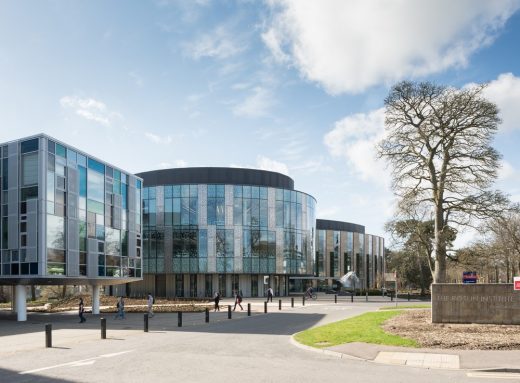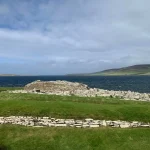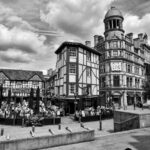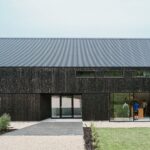Neoclassical Architecture in Scotland, Robert Adam Architects, Scottish Buildings
Architecture Debate : Neoclassicism + Design Codes
Discussions on Current Architectural Topics
15 Aug 2005
Neoclassical Architecture + Design Codes
New Ubanism – Neoclassical Architecture
Scottish Neoclassicism Text: Adrian Welch, architect
Robert Adam Architects Masterplan for Forth Ports PLC, Edinburgh
Can neoclassical architecture survive into the 21st century? This site at Leith Docks is perfect for it to prove itself. Barren, wind-battered no-mans land within a post-industrial landscape of northern Europe. But, on further investigation, the approach is not specifically ‘neoclassical’ at all, but ‘integrative’ or ‘holistic’, according to a senior architect-planner in the City Council.
Currently a waste of spoil tumbling ever outwards into the dank Western Harbour the site is bounded by fallen greats and fledgling apartment stacks. Industrial beasts to the south of the site are slowly clearing as new commercial & residential animals arrive.
Robert Adam Architects were brought in by invitation of Bellhouse Joseph: Forth Ports commissioned them in 2002 to masterplan an area of 33 hectares at Granton Harbour and 45 hectares at Western Harbour. Previous masterplanners were Cooper Cromar Architects – who controlled Phase One, Platinum Point – and before them it was CDP, now known as Conran & Partners. The main issue with the masterplan seems to be sticking to it!
The term used by RAA to describe the masterplan is ‘new urbanism’ and according to key people in Planning the design codes should be really successful. Discussions between the Council and the architects were apparently very productive and a stimulating ‘partnership’ has developed: Robert describes CEC as being ‘most supportive’.
Right from the start RAA involved traffic engineers and landscape architects in a multi-disciplinary approach that “really impressed the planning committee” according to Ian Spence. The masterplan “took (CEC) involvement to another level”. The eclectic approach however needs “advisory control on materials” according to Ian. I must emphasise that RAA are not involved in designing specific buildings and the architecture may have no neoclassical elements at all.
Unlike some exponents of traditional architecture, Robert Adam embraces contemporary architecture. I share his enthusiasm for a wide range of approaches and believe this new eclecticism makes British architecture stronger today than it has been for many decades. Robert Adam describes himself as a ‘progressive classical architect’ and founded the International Network for Traditional Building, Architecture & Urbanism in 2000. He has been involved with masterplanning work as far afield as Japan, the US, Ireland and Germany. Robert refers to similar projects in terms of intellectual concept, as being “Poundbury, New Urbanism in USA (however, this masterplan is specifically European) and Upton, Northampton (The Prince’s Foundation)”.
The key word for me here is Pluralism. My initial reaction on hearing Robert Adam Architects (RAA) were to become the latest in a long line of masterplanners on Edinburgh’s waterfront was one of disquiet. Being from the generation that was fed a diet of Mies & Corb there’s a learnt dislike of anything ‘not modern’. But there’s something healthy about the current increasing rejection of dogmas and opposing ‘isms’ and therefore I am interested to see how RAA proceed here.
After all, they are apparently only creating design codes and a masterplan framework within which other architects can operate. Each site “has to be commercially viable so individual developers can buy into it” according to Ian Spence. RAA have been portrayed in the Press primarily as designers of private neoclassical houses but in fact they are producing many other housing projects.
Frequent references to the masterplan being a ‘second New Town’, or ‘as good as the New Town’, are irritating and won’t be repeated here: quite frankly these claims are daft. I first heard them in association with a neighbouring masterplan in Granton and clearly they are bullish claims made to sell property. But I don’t think we should ignore these statements as I get the feeling there are some who hold an intellectual belief in the ability to recreate the Georgian New Town.
Obviously nobody in 2005 has the finance to create a large new community out of stone, let alone achieve the powerful layering of qualities built up over time in Edinburgh’s New Town. There is nothing wrong with an aspiration to emulate the New Town but it cannot be repeated. There may be squares and crescents but this is essentially a new suburb on reclaimed land, end of story.
Rather than basking in reflected glory of a successful but unrelated townscape, any masterplan – whether modern or neoclassical – will have to try hard to beat the wind and to integrate with the working docks. Located on the edge of the Forth the wind can really howl down here. Robert Adam states, “The masterplan specifically deals with climate. The broken and irregular street grid has a deadening effect. The wind tests now prove this.
Also the major street is set back from the water (but is within the scheme)”. The site also faces an industrial landscape to the east that may not be to every potential penthouse purchaser’s taste, but potentially quite stimulating for some. The view to the south-east looks down on a lifeless dock at present but soon to be interrupted by the promontory of Ocean Terminal 2. However, the former Royal Yacht Britannia is moored on the far side of Western Harbour, and the views north over to Fife from many apartments will be stunning.
The huge expansion of homes will be accessed by largely unchanged routes through the city like Ferry Road and Commercial Street: efforts to reduce car use should be absolutely firm but I suspect most homes will get a car space and the bus service will be similar to any other Edinburgh suburb. The tram route should pass nearby, but then that was the case when I worked on the Ocean Terminal many years ago. Development has to be sustainable at a macro scale.
Today’s neoclassicists give themselves a real challenge: melding traditional architecture seamlessly to modern technology seems almost impossible. Neoclassical urban planning on the other hand can work well provided it embraces the society of today: crescents, circuses, squares and terraces are wonderful things. Because they are simple, symmetrical shapes, they attain a natural focus that some contemporary urban schemes fail to achieve.
Architects such as Edwin Lutyens showed the way by borrowing intelligently from classicism and assimilating elements into a convincing holistic style of his own, and Robert Adam appears to follow this lead rather than the dogmatic approach of say Quinlan Terry. Richard Murphy was quoted as saying “the plan is full of common sense and pragmatic guidelines, avoiding the rigid dogma of so much planning thinking. It should rightly become the organising device for a whole series of architects’ contributions to the city”.
The Allied Mills site adjoining the new urbanist masterplan must be mentioned. It contains three strong buildings: a large rectilinear brick Mill that is half demolished, a white rectilinear tower with simple punched openings and Corbusian floating frame at the top, and a square group of white silos. Other sheds drift around and need clearing quickly but this three-strong hinge is richly powerful and could surely be intelligently reused. Elsewhere in Europe silos have been turned into luxury housing for example. These buildings should be the core of a revitalised Leith Docks, providing a historic anchor.
The RAA site is located on the southern half of a triangular finger of land between the sea and the Western Harbour. The latter is within dock gates so has no tide and becomes home to around 80 cruise ships per year and occasional naval vessels. On most days it feels rather barren but there are proposals by RMJM – masterplanners for the vast majority of Leith Docks in a swathe of land to the south of this harbour – to poke out an extension for the Ocean Terminal into this piece of water.
Maybe logistics make it impossible – small cruisers sharing the locks with cargo ships and cruise liners – but, like the adjacent Victoria Harbour, this expanse of water needs uplifting marinas, boardwalks and other sources of human activity. If marinas are out of the question then activities such as windsailing could be introduced. The space is so dominant but not at present in a positive way: it has to make the transition.
So good luck to Robert Adam Architects, I hope a stimulating new quarter is created using sustainable buildings suited to the site and climate. I hope they will be supported by a magnificent set of urban spaces. I hope Forth Ports can really get to grips with ensuring public transport is available to all. And, whatever style the buildings are designed in, if quality is achieved this community has enormous potential with its superb views over the Fife and should be supported. It is after all Edinburgh & Lothian’s only real chance to close the housing shortage without destroying chunks of countryside.
Adrian Welch – e-architect Editor
Location: Scotland
Architecture in Scotland

image Courtesy architecture office
Charnock Bradley Building Roslin
Comments for the Neoclassical Architecture in Scotland page welcome



